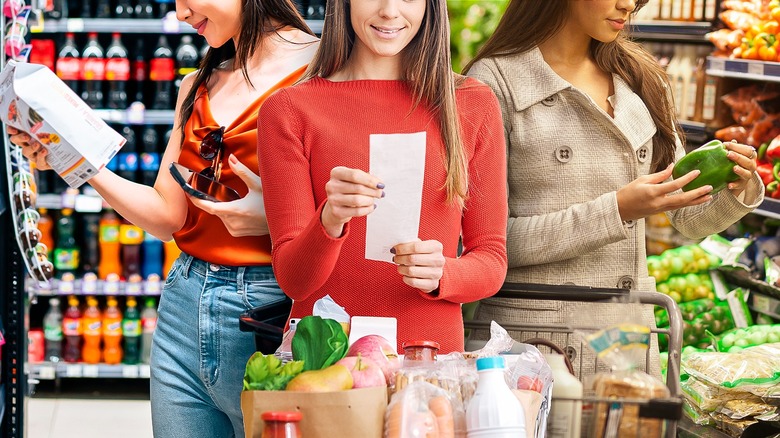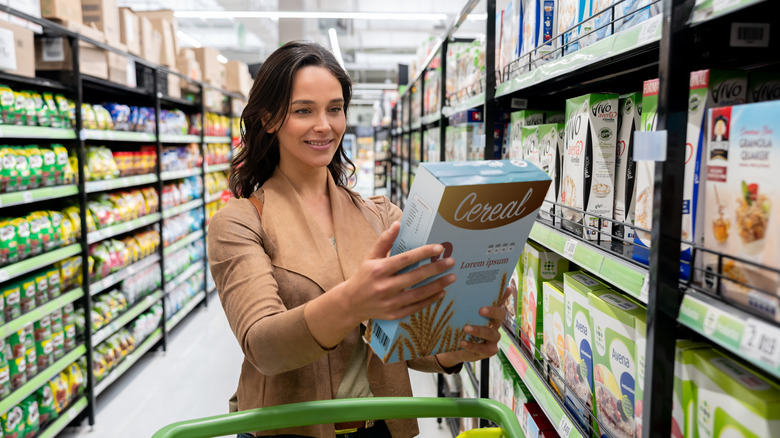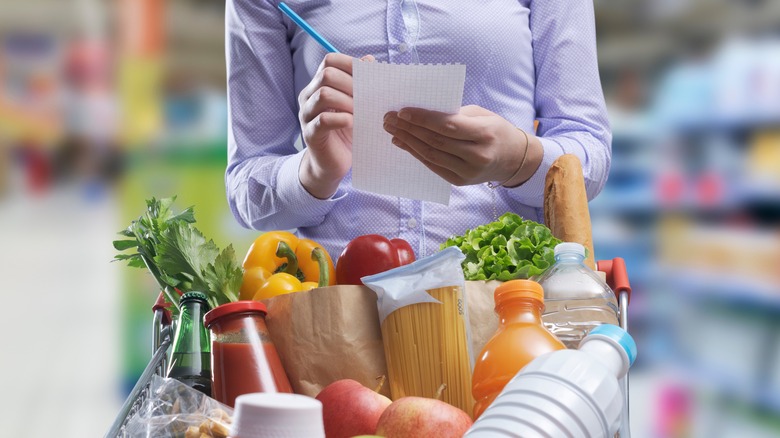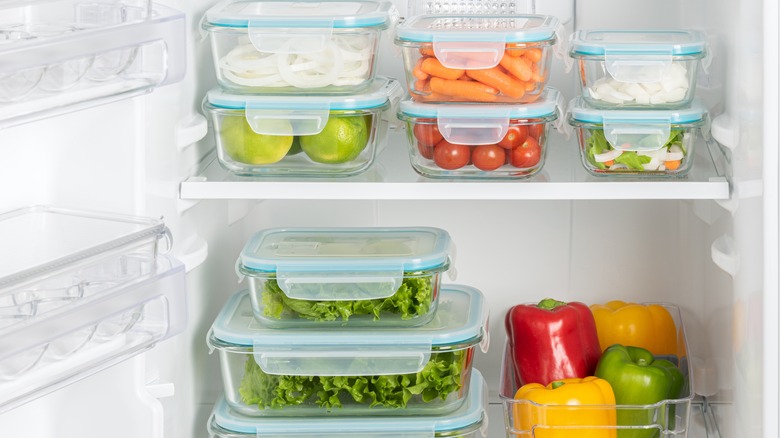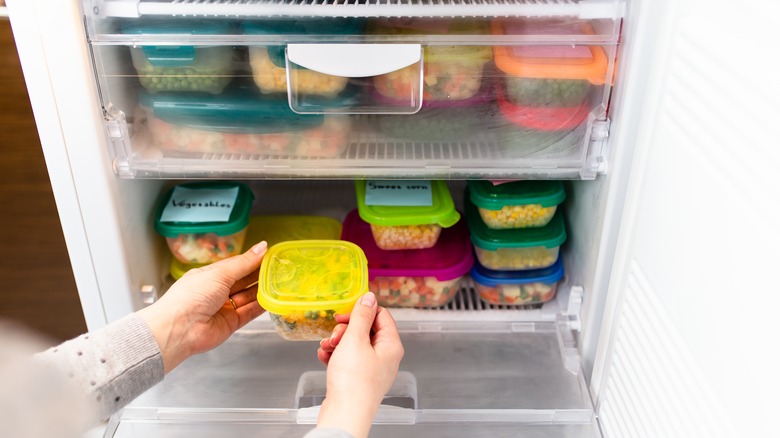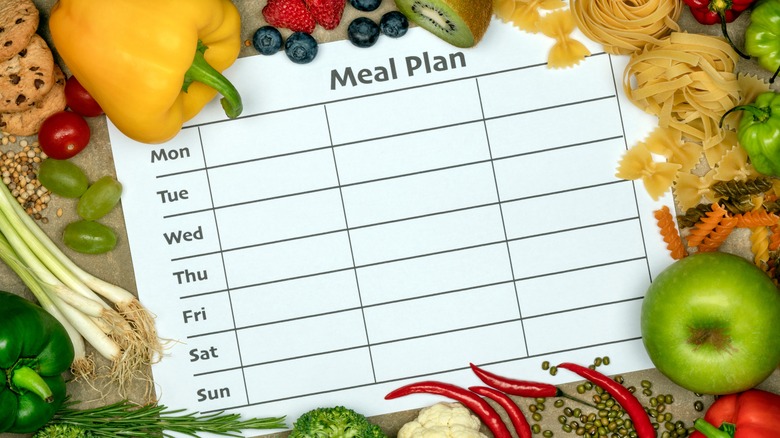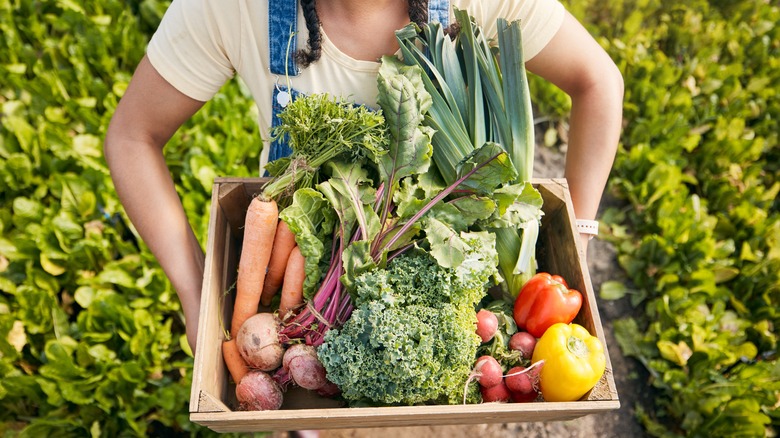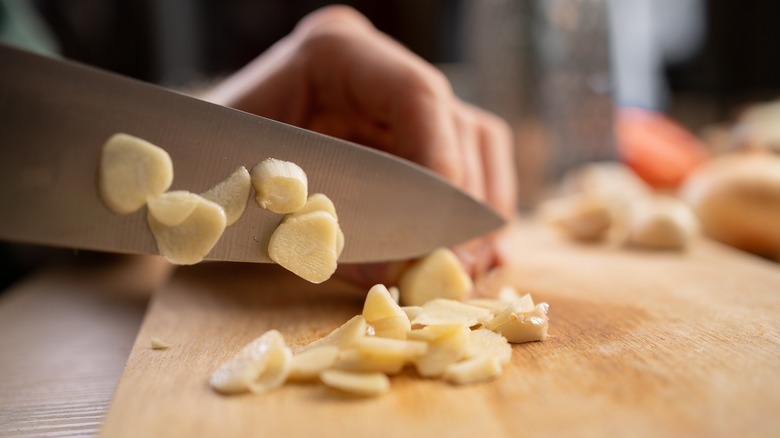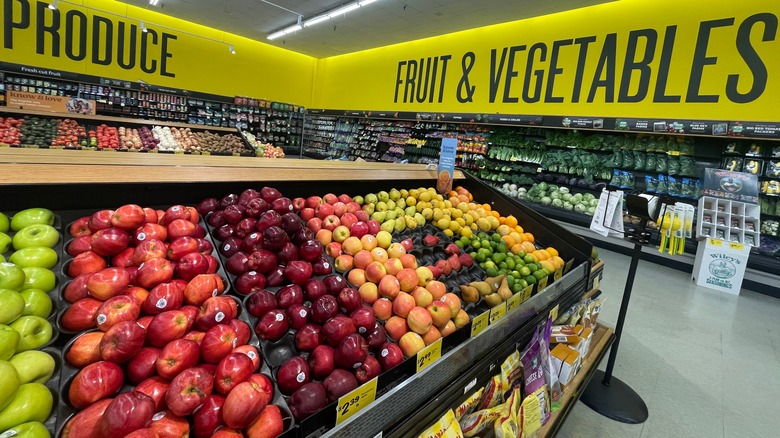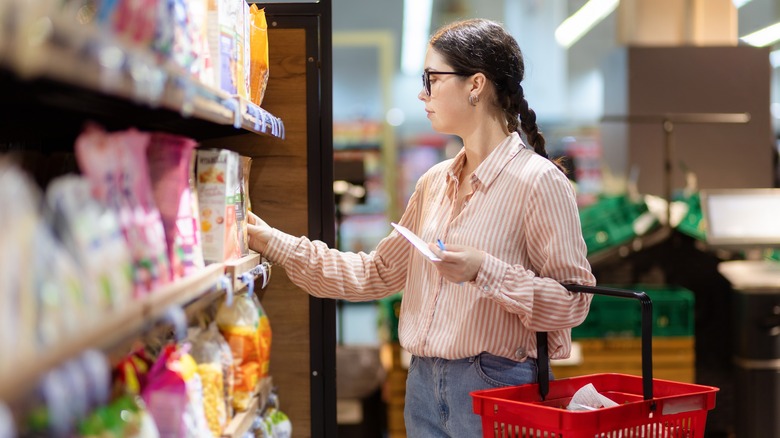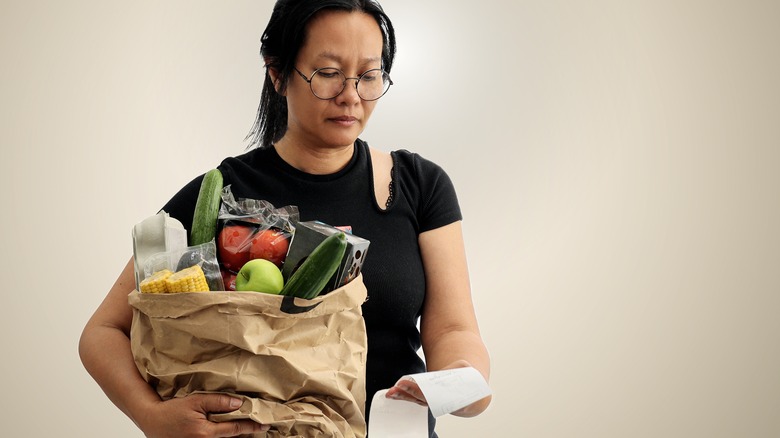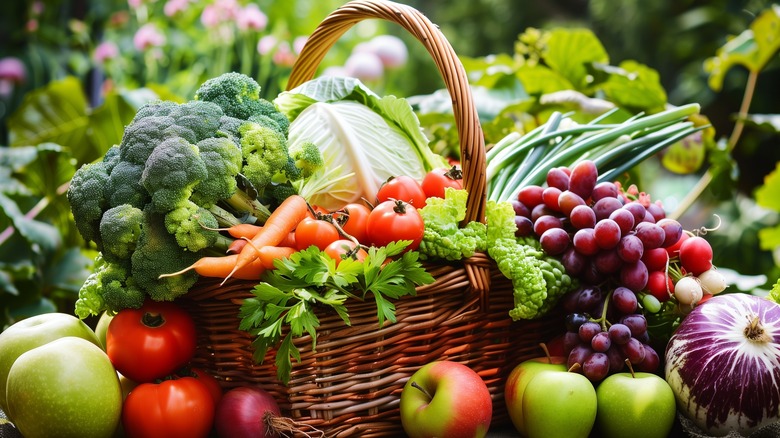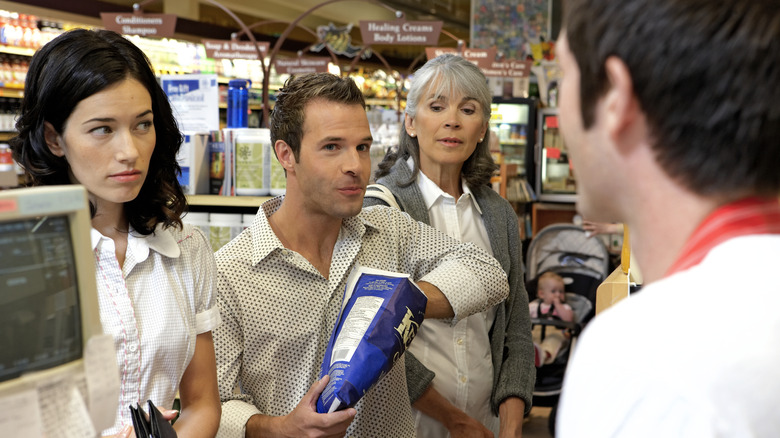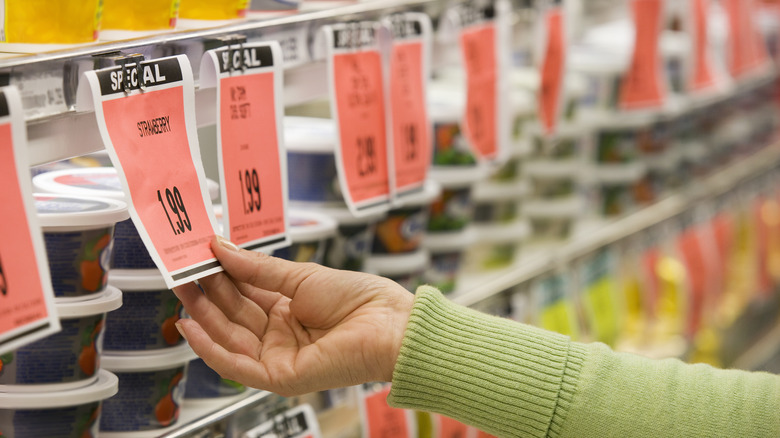13 Grocery Shopping Mistakes You Don't Realize You're Making
Grocery shopping — whether you love it, hate it with a passion, or just like to get it done and move on — is a task that we often sail through on autopilot. No matter how you approach your weekly shop, there are a few traps that the majority of us get caught in at some point. With the price of groceries seemingly always on the rise, avoiding mistakes and pitfalls that can add to the cost of your shopping feels as important as ever.
Whether you're guilty of falling for the marketing of the big brands or not utilizing your freezer properly, with a few simple tweaks, you can make your shopping experience more efficient and budget-friendly. So before you sit down to write your shopping list — and trust me, you're going to need one — let's look at the common grocery shopping mistakes that you didn't even know you were making.
Always sticking to brand names
Many of us are guilty of sticking with what we know while grocery shopping. It's much easier to get the shopping done quickly if we fly around the aisles, throwing the same branded goods in our baskets each time, without looking at the alternatives. But always buying the big brand could burn a hole in your pocket, and it doesn't always mean better quality.
Per The Standard, U.K.-based consumer group Which? found that in a blind taste test, Heinz mayonnaise was beaten by a supermarket's own brand at approximately half the price, while its baked beans cost almost three times that of the store brand that came top. This echoed the famed Consumer Reports study from way back in 2012, which found that store brands often rate as highly as big name ones.
The next time you are at the grocery store, keep an eye out for own brand foods that are significantly cheaper than your usual brand. Why not try the cheaper brand for a week and see if you notice the difference? If you are buying for other members of the family, don't even tell them you have switched. You can always go back to the big brand if you feel the cheaper one is inferior, but you may be surprised at how similar it is. Many store brand products are made in the same factories as the big brands, so your taste buds may not even notice the difference — but your wallet will.
Shopping without a list
If you head off to the grocery store without a shopping list, you're asking for trouble. Without a firm plan, you will end up browsing through the aisles buying items you don't need, and the bill will quickly rack up. You're also more likely to forget a couple of essential items, which means you will have to make a second trip at some point. Jotting down a quick list before you leave the house will at least give you a rough idea of which areas of the store to target first.
Of course, you don't need to settle for the traditional pen and paper if you find that a bit old school. There are plenty of smartphone apps that will allow you to add to your list throughout the week, and others in the house can adjust them from their own devices too. This means you can't be blamed for forgetting to add your partner's favorite drinks or chips for the kids!
If you have time, you can even organize your list according to the aisle each item is found in, keeping your trip as efficient as possible. No matter how hi-tech your list is, taking one to the store is crucial, so spend a few minutes in advance to save you in the long run.
Failing to organize your fridge before you go to the store
After a long shopping trip, there's nothing more frustrating than lugging your bags of groceries into the kitchen and opening the fridge only to be greeted by a disorganized mess. It's difficult to be enthusiastic about the delicious meals you are about to prepare when there is nowhere to store your fresh ingredients for the week.
Sorting out your fridge before you head off to the store will streamline the whole process and likely save you money in the long run. You may discover ingredients you didn't realize you had, such as a bag of lemons in the vegetable drawer or a jar of mustard languishing at the back of the fridge. It can be especially helpful to do this task before you start your meal planning for the week, as you may be inspired by ingredients that you had forgotten about.
Once your fridge is spotless and organized, you can head off to the store with a smile knowing there will be plenty of space for your fresh produce when you return. When refilling the fridge, place the ingredients that have the longest shelf life at the back, and keep the more urgent foods to the front, to avoid anything going bad without you realizing. This simple routine can cut down on food waste and reduce the stress of mealtimes — something we could all do with after a busy day.
Forgetting to check freezer space before buying in bulk
Before you head out to the store, it is important to check not only your fridge space but your freezer space too. You don't want to shell out for a extra large pack of meat that is on sale just to find that your freezer is already bursting at the seams. This could lead to increased food waste as things that you had planned to freeze will have to be eaten more quickly than anticipated.
You may be able to create extra space in the freezer by reorganizing it before you go. If you have numerous half-empty boxes, consider consolidating and transferring them to freezer bags instead, which could considerably reduce the space they take up. For future reference, liquids such as soup or sauces can be added to plastic freezer bags and frozen flat, rather than in tall plastic containers that take up lots of space on the shelf.
Not planning your meals for the week
Meal planning may seem like a task that only super-organized people with lots of free time can accomplish, but realistically, spending a few minutes each week sorting out your meal ideas is going to save you time and money overall. Going shopping without a meal plan will result in you buying more ingredients than you need and potentially reaching for overpriced convenience food when you run out of ideas.
The reason meal planning is so effective is that it allows you to tailor your meals to the ingredients you already have in your fridge, freezer, and cupboards. You can also save money by buying large quantities of meat and using it for multiple meals throughout the week. For example, a roast chicken on a Sunday can lead to chicken tacos or chicken salad later in the week.
In many cases, meal planning will lead to you eating more healthily, too. If all of your weekly meals are already determined before you get to the store, you won't find yourself enticed by the junk food aisle in quite the same way. There are plenty of apps that help you to plan your meals, as well as websites that allow you to enter the ingredients you have and will suggest meals you can make. Tools like that can make meal planning much more approachable and potentially even turn it into a fun family activity.
Automatically buying everything organic
In an effort to keep yourself and your family as healthy as possible, you have likely considered buying organic. Organic is a word that automatically makes us think the food is better for us, but it comes with a hefty price increase over conventional produce. This is because the cost of growing organic, small-batch produce is more expensive, and farmers need to pay for certification too. Since most of us can't afford to buy everything organic, the key is understanding which organic foods have the biggest impact on our health.
The main concern with conventionally grown produce is pesticides, which can be absorbed by the body and cause disease. The Environmental Working Group (EWG) releases two lists every year documenting the crops in the U.S. with the most pesticide residue, and those with the least. The 12 worst-affected crops make the Dirty Dozen list, and apart from cherries, each one had at least 50 different pesticides present in 2024. Unfortunately, many family favorites are on this list, including apples and grapes, with strawberries the worst offenders. You should aim to buy these 12 fruits and veggies in their organic form whenever you can, as this will definitely be worth the extra expense.
The good news comes in the form of the EWG's Clean Fifteen list, which is where you can save money. These 15 crops are the lowest in pesticides, with 65% containing none at all. You can buy conventionally grown avocados, carrots, and mushrooms with a clean conscience, meaning you can save the money to put toward organic strawberries instead.
Buying pre-prepped food
No matter how keen a home cook you are, we are all guilty of taking a few shortcuts in the kitchen, and convenience food is a sure-fire way to shave a couple of minutes off here and there. Granted, chopping an onion may only take a few moments, but the promise of a pre-chopped bag of onions that will save you the effort of peeling and slicing — and, of course, crying — can be too tempting for you to walk past and purchase the whole onion at a fifth of the price. But too much convenience is certain to take its toll on your bank account over time, as well as reducing the quality of your ingredients by the time they make it onto your plate.
The same logic applies to ready-made meals that can go straight into your oven or microwave without any prep at all. Each individual meal may not seem that much more expensive than the ingredients themselves, but if you are meal planning and buying in bulk, making food yourself will be significantly cheaper in the long term.
To make cooking from scratch easier, plan to cook straightforward meals with only a few ingredients that need to be prepared, and not too much washing up afterwards. If you have one day of the week where you have more time on your hands, you can always pre-chop all your veggies for the week and stick them in the freezer. That way, you will have the convenience of pre-prepared ingredients at a fraction of the price.
Not sticking to the perimeter of the store
It may surprise you to know that how you navigate the store will make a difference to how healthy your shopping cart will be by the time you reach the checkout. In the majority of supermarkets, the healthiest food will be found in the aisles around the outside of the store, whereas the center is home to shelf stable foods that tend to be more processed.
At the entrance to most grocery stores, you will be met with the fresh produce department, housing fresh fruits, vegetables, and herbs to pack your homemade meals with nutrition. You may also find nuts and seeds here which can add high-quality protein to your breakfasts and snack times.
The next few aisles or the back wall of the store are where you will likely find the meat, fish, and dairy, allowing you to buy fresh ingredients for your home-cooked dinners. The interesting aspects of all of these foods is that they are free from the marketing campaigns that most of the rest of the store is subject to. If you have children (or easily swayed adults) with you, they are less likely to fall into these big brand traps.
The middle of the store will bring you to the boxes and cans of processed foods, such as sugary cereals, instant noodles, and soda, among countless other things. If you are trying to cut any of these sorts of items out of your diet, it is best to avoid these aisles completely. They represent poor value for money in addition to their anti-nutrient ingredients.
Reaching for the items at eye level
If you've ever walked into your local grocery store and been frustrated that you can't find your regular groceries because the store has moved everything around, you may wonder why it was done at all. A huge amount of psychological insight goes into the decisions on where to place products in the store, with the number one aim being to persuade customers to purchase the most profitable items or to spend as much as possible. Candy bars at the checkouts, for example, are not there by accident — they're placed as potential impulse buys as you load your cart onto the conveyor belt.
Eye level is considered to be the prime area for selling to shoppers, since most of us are unlikely to crouch down or stretch up to look for alternatives if there is a perfectly good item right in front of us. Some brands even pay a premium to be placed on eye level shelves, meaning you may be missing out on a better value or quality item by simply sticking to the same part of each shelf.
Now that you are armed with this knowledge, you can outsmart grocery marketing psychology by standing back and taking a look at the entire shelf before making your choice. Also, don't automatically take foods that are on special offer at the end of the aisle, as without the rest of the shelf to compare to, you won't know if you are actually getting a good deal.
Shopping without a budget
Going grocery shopping without a budget in mind is a recipe for disaster. If you don't know how much you have available to spend, how will you know if you have bought too much? According to a 2019 CFP Board poll, two in five Americans have never had a household budget, meaning that 40% of people aren't even aware when they are spending too much. If you want to get your grocery shopping under control, the only option is to take the time to work out how much you should be spending before you go.
If you don't know where to begin, you can start by collecting your grocery receipts for a few weeks and examining where you have been spending more than expected. Be sure to include all takeaway food and coffee in the total, as these items can quickly add up and increase our overall food spend. Once you have worked out your average weekly food spend, you can compare it to your monthly income and decide whether you need to make changes.
Buying produce out of season
You have likely heard that you should buy seasonal food whenever possible, but do you know why? Aside from the fact that it tastes so much better — if you have ever tucked into a perfectly ripe strawberry or peach in summer, you already understand the difference — it can actually save you money and reduce your carbon footprint.
In most cases, seasonal food will have been grown locally, meaning it hasn't traveled far to reach you. The reduced cost of transportation means the savings can be passed on to you, the consumer.
In addition to less carbon being produced on the journey, compared to the same produce being imported later in the year, the nutrient profile will also be improved. The longer the food is stored, the more the nutrition level will drop, meaning seasonal produce is the best option for your health too.
Going shopping while hungry
No matter how rigidly you are planning to stick to your shopping list, every so often a product might catch your eye. Before you know it, it's in your cart. It happens to the best of us, but these impulse buys can add up over time, leading to increased grocery bills and a large dent in your wallet.
Although the grocery store is set up deliberately to encourage these spur-of-the-moment buys, there are measures you can take to help prevent them, starting with making sure you have something to eat before heading to the store. Shopping while hungry means you will have much less control over what you buy, driven by your desire to fill your stomach rather than fill your cart with healthy food for the week ahead. By only shopping when your hunger pangs are at bay, you can happily stick to your list and reduce the chances of adding unexpected items to your basket.
Looking at individual prices instead of unit prices
In the rush to get your shopping trip finished at the end of a busy day, you may find yourself reaching for the cheapest option to add to your cart — but just because it's the cheapest doesn't automatically mean it's the best deal. Few of us have the time or inclination to do the math involved to work out whether different sized packs are the same value, but by keeping an eye on unit pricing, you can quickly work out which one is the best option.
Unit prices allow you to compare the cost per pound or per liter across the same item packaged in different sizes. You will usually find the unit price on the shelf, in small letters under the main price tag. By taking a few extra seconds to compare the unit prices during your grocery shop, you could find yourself saving a significant amount as the savings start to add up over multiple trips to the store.
